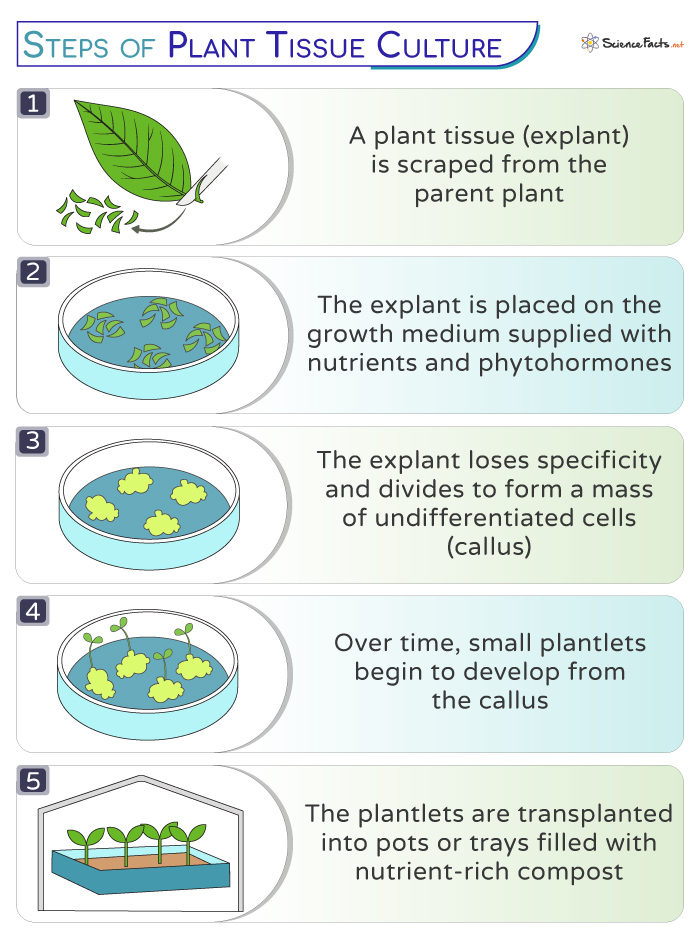Plant Tissue Culture
Plant tissue culture is a technique plant breeders use to grow and reproduce new plants from pre-existing ones. It involves cultivating plant cells, tissues, or organs in an artificial medium under controlled temperature, light, and humidity.
It is widely used nowadays to produce disease-free plants, including ornamental plants, food plants, and orchids, rapidly on a large scale and with desirable qualities. The process is known as micropropagation, when tissue culture is used to develop identical plants from a single parent.
History of Plant Tissue Culture
Gottlieb Haberlandt, now known as the father of plant tissue culture, proposed the theoretical basis of plant tissue culture in 1902. He experimented with photosynthetic leaf cells but could not induce any growth. However, he predicted that one can obtain artificial embryos from vegetative cells using this culturing technique and established the concept of totipotency.
Principles of Plant Tissue Culture
Plant tissue culture depends on two fundamental principles of cells:
- Totipotency is the capability of a plant cell to divide and differentiate, regenerating a whole plant.
- Plasticity is the ability of plants to change their growth, metabolism, and development based on their environment.
Procedure of Plant Tissue Culture
- Plant tissue culture begins with an explant, a plant part used as the starting material. The explants used include leaf, stem, root, petiole, hypocotyl, cotyledon, embryo, or meristem.
- They are cultivated in vitro on a nutrient medium that supplies all the required nutrients for their growth and metabolism. Apart from macro and micro-nutrients, the growth medium is also provided with phytohormones (plant growth regulators), which stimulate the morphogenesis of plants.
- During growth, the explant first loses its specificity and divides to form a mass of undifferentiated cells, known as callus. The callus then gradually develops into an organ or a complete plant as per the requirement of the cultivator.
- Finally, the plantlet is transferred to compost, developing into an adult plant.
Types of Plant Tissue Culture
Callus Culture
A callus (plural: calli) is a mass of undifferentiated cells arising from explants in vitro. It is often used in the propagation of plants with desirable traits and as a starting point for genetic modification.
Embryo Culture
In embryo culture, the embryo of a plant seed is first isolated and then cultivated under in-vitro conditions. It is crucial for rescuing embryos from seeds that may not germinate under natural conditions. Embryo culture propagates plants with low seed viability or for breeding purposes.
Seed Culture
In this technique, the seeds of a plant are grown under in-vitro conditions. Seed culture is valuable for mass propagation, especially when seeds are scarce or exhibit low germination rates. It allows the production of many plants from a limited seed resource.
Protoplast Culture
Protoplasts are cells with their cell walls removed, which allows them to be cultured as individual cells. Protoplast culture is employed in genetic modification and the creation of hybrid plants. Protoplasts can be fused to form hybrid cells with combined genetic traits.
Organ Culture
Organ culture involves cultivating entire plant organs, such as roots, shoots, or leaves. This technique helps study organ-specific responses to various stimuli. It also plays a role in the micropropagation of plants with intact organs.
Other Types
Some other types of plant tissue culture less commonly used are:
- Single-cell culture involves isolating and culturing individual plant cells. It is used to study cellular responses and behaviors in plants.
- Suspension culture consists of cultivating plant cells in a liquid medium, allowing cells to float freely. It is valuable for the large-scale production of plant metabolites.
- Anther culture deals with cultivating anthers, the male reproductive organs, in a nutrient medium. It is employed in the production of haploid plants.
- Pollen culture involves the cultivation of pollen grains that give rise to plants with desired characteristics.
Applications of Plant Tissue Culture
Plant tissue culture provides numerous advantages for scientific research, crop improvement, and conservation efforts.
Clonal Propagation
Plant tissue culture allows for the propagation of plants with specific and desirable traits. Clonal propagation ensures the preservation of unique characteristics, such as disease resistance, high yield, or enhanced nutritional content.
Rapid Multiplication
The micropropagation technique enables the rapid multiplication of plants from a single source. This efficiency is particularly valuable for massively producing elite plant varieties on a large scale.
Techniques like anther and pollen culture facilitate the rapid generation of haploid plants. It expedites breeding programs, allowing new plant varieties with desired traits to be developed quickly.
Preservation of Desirable Traits
Plant tissue culture allows for the propagation of plants with specific and desirable traits. This clonal propagation ensures the preservation of unique features, such as disease resistance, high yield, or enhanced nutritional content.
Genetic Modification
Plant tissue culture provides a controlled environment for introducing and expressing specific genes in plant cells. This precision in genetic modification allows for breeding crops with improved traits, such as resistance to pests or tolerance to environmental stress.
Disease-Free Plants
Through the process of surface sterilization and aseptic conditions, plant tissue culture helps in producing disease-free plants. It is crucial for maintaining the health and vigor of plant materials, especially when propagating from valuable or endangered species.
Seasonal Independence
Plant tissue culture enables the production of plants independent of seasonal constraints. This year-round availability benefits continuous research, crop production, and conservation efforts.
Conservation of Germplasm
In the face of biodiversity threats, plant tissue culture provides a means to conserve and propagate endangered plant species. This germplasm preservation contributes significantly to biodiversity conservation and ecosystem restoration.
Fundamental Research
Plant tissue culture provides a controlled environment for studying fundamental aspects of plant physiology and biochemistry at the cellular and molecular levels. It also serves as a valuable tool for advancing our understanding of plant biology.
-
References
Article was last reviewed on Friday, May 31, 2024




